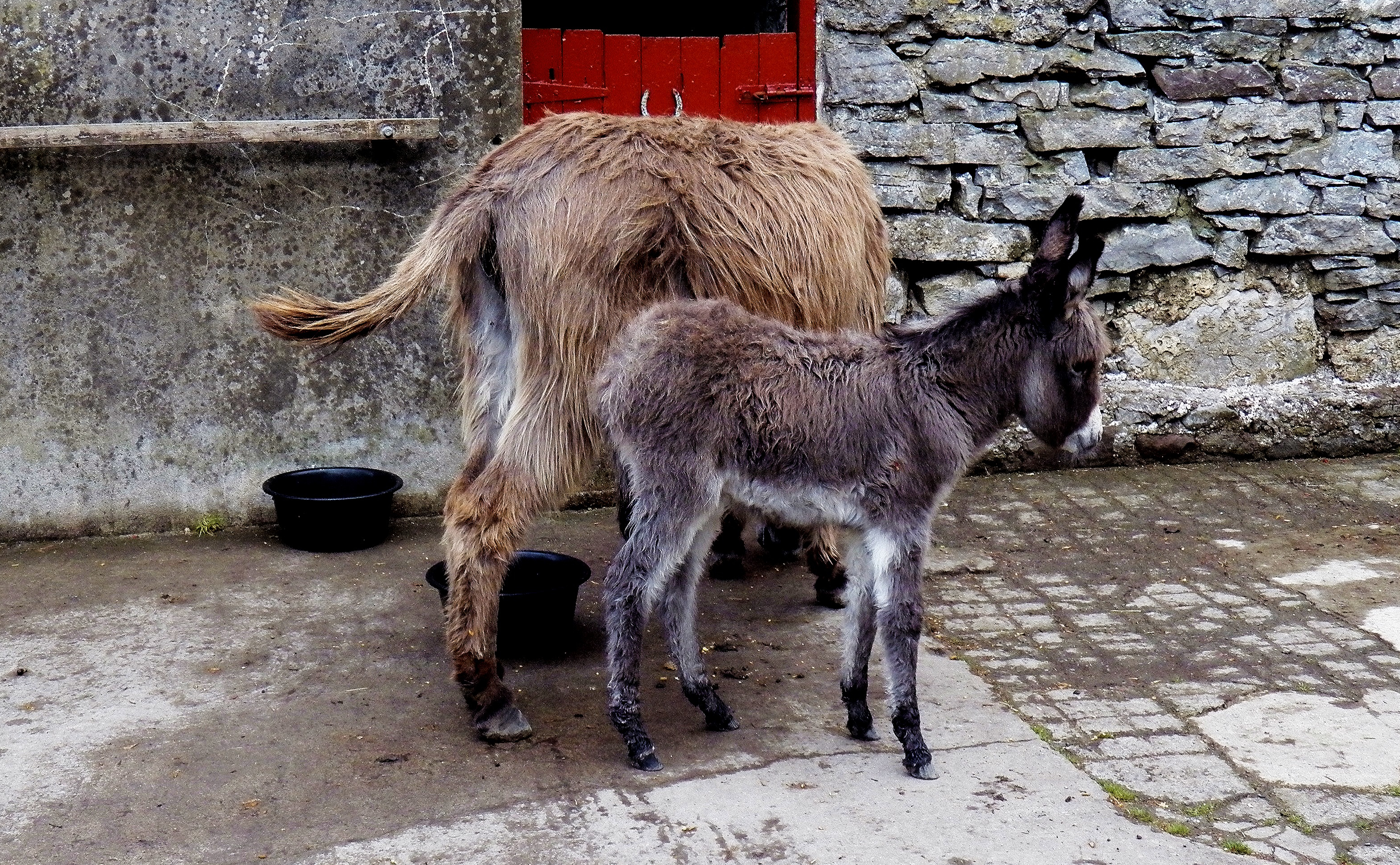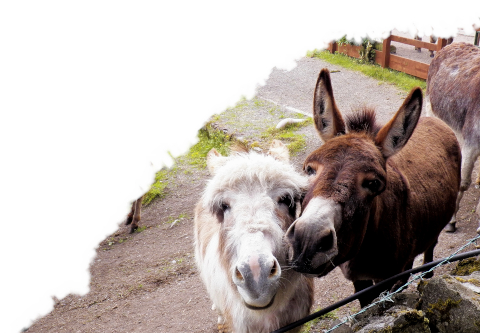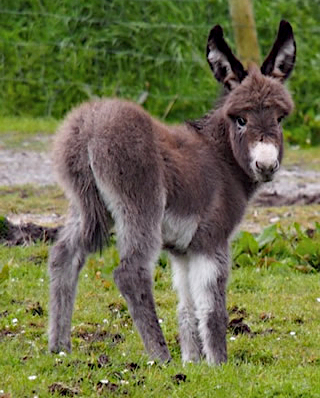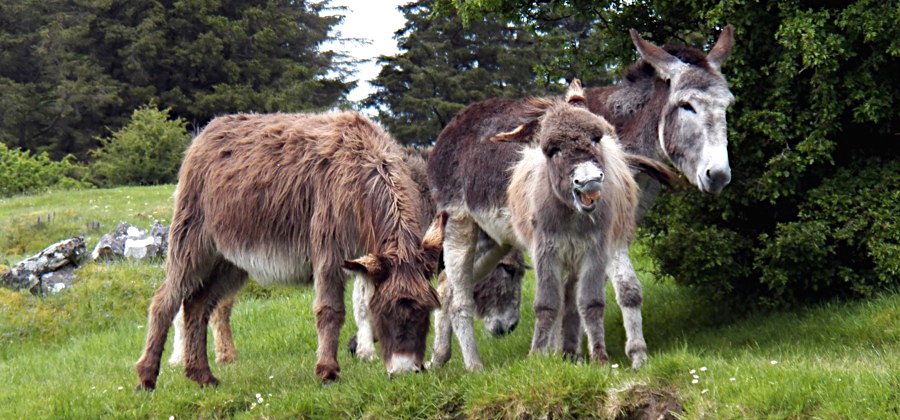Care of Orphan Donkey Foals
A foal may be orphaned because of its dam's death, antagonistic behaviour or inadequate milk. Alternative means of maintenance must be found until about 5 months of age.
Fostering
Finding a nurse mare has many advantages but they are rarely available. A mare that has just lost her foal is the ideal situation though the success depends on a number of variables affecting the mare to foal relationship.
- Mares who have had a still born foal or who have not suckled are less likely to accept another foal.
- The longer the period between the death of the mare's foal and the introduction of the orphan foal, the less chance of success. After 2 to 3 days of not suckling the mare will dry up.
- If the size discrepancy between the mare and foal is great, the chance of acceptance is less.

- If a foal has never sucked from a mare it gradually loses the instinct. If the foal gets kicked during the first meeting it is unlikely to want to try and suckle. Careful handling is necessary to try and avoid this at the crucial first encounter.
- The mare's mothering instincts vary from one mare to another. Some show extreme hostility at first but once they accept a foal they can make the best mothers.
There are a number of ways to help overcome or avoid rejection:
- Place a strong smell over the mare's nostril eg. Vick vapour rub. Also place this on the foal, especially over the buttocks and hindquarters, head and neck (mind the eyes). Renew this at frequent intervals.
- Remove the mare from the place where she had been with her own foal to break the attachment. Place in a clean box or stall.
- If possible, smear the amnion, meconium or hide from the dead foal over the orphan foal before presenting it to the mare.
- Put the foal to the mare for the first time when it is hungry, ie: 3 hours after a feed, and make sure the mare has a full udder.
- On the first meeting, and then less each time, restraint may be necessary such as chemical tranquillisers.
- Once left together for the first time alone, observe closely for several hours, as the foal is still in danger from the mare.
- Some mares are best kept separated from the foal by a partition which allows sight and smell, but which protects the foal whilst left unattended. The foal will soon learn that the presence of a person is its trigger to feed, whilst the mare is being held.
- If unsuccessful at first encounter, re-introduce the foal after a break. Success may only be achieved after the second or third attempt. If the mare is still showing antagonism towards the foal after 10 -12 hours, then the chances of success are poor.
Milk Yield
If a mare is not producing enough milk for her foal it can be supplemented using the following diet suggestions whilst suckling. To avoid low milk yield, feed the mare extra concentrate during the last trimester if the body condition falls below condition score 3. Various methods of increasing milk yield have been found to be successful.
- Injection of oxytocin 0.5 to 1.0ml to stimulate milk let-down
- Turn out on lush grass
- Feed lucerne
- Add fennel seeds to feed

There may be no alternative but to feed the newborn foal.
There are three methods.
- BOTTLE FEEDING - This is time consuming but preferred by the foal, especially if new born. It could be used for the transition period before it can be trained to drink from a bucket. Rubber teats for feeding lambs are the closest in shape and pliancy. If the foal rejects the teat, place your index finger in the foal's mouth. If it does not suck, try moving the finger against the roof of the mouth. Slowly replace the index finger with the teat once sucking begins. This can take some patience. Keep the bottle in an upright position. It is important to keep strict hygiene. Sterilise the equipment after each use. Do not leave the preparation standing once made up. Warm up the mixture to 38C degrees and gradually reduce this to air temperature over the first week. As soon as possible teach the foal to bucket feed.
- BUCKET FEEDING - This is less time consuming once trained but much harder to introduce than the bottle. It is usually best started once the foal is two weeks or older. Fresh milk or milk replacer is offered ad-lib. Use a wide, shallow bucket placed at head height. Replace with fresh milk (or mix) and clean the bucket twice daily. To train the foal, again place your fingers into the foal's mouth and as it begins to suck, slowly lower your hand into the bucket of milk. You may need to push the foal's head down to show it the bucket. At worst it may take a whole day to teach a foal to drink from a bucket!
- NASOGASTRIC INTUBATION - If the foal is very weak and unable to stand, feeding by a nasogastric tube is required. It can be quite difficult to insert the tube. Use great during placement and ensure that the tube is in the esophagus. The foal will resent repeated insertions and trauma will be caused to the tissues also. Use the smallest diameter tube available - 10 or 12 French diameter, and cap the end to avoid aerophagia. The tube can be secured into place.
Colostrum
Within the first 12 hours of life colostrum must be administered to the foal. Ideally the first feed should be given during the first 2-4 hours after birth. Recommended amounts: 250 mls of colostrum every hour for the first 6 hours, a total of 1.5 litres.
Preferably the colostrum can be obtained from the mare in the case of rejection, or any other mare within 2 days of giving birth. A good milker will have enough for 250mls to be taken off after her own foal has sucked. Cow colostrum is NOT suitable, although if fed in large quantities it is better than no colostrum at all.
Cleanliness is extremely important. Clean hands and udder before milking the mare and sterlise all utensils.
An established breeding centre will collect and freeze colostrum whenever possible. Colostrum can be kept frozen at 15-20C. Ideally store in 250ml batches and defrost slowly in hot water until it reaches 38C as required. If the foal has received no colostrum then plasma (preferably from the foal's own mother) must be administered intravenously or by stomach tube during the first 12 hours.
What is Colostrum?
Colostrum, the mare's first milk is extremely rich in antibodies which provide new born foals with protection against infection. Foals cannot produce antibodies of their own when they are first born and until they ingest colostrum they are incapable of fighting infection. A foal must receive colostrum within the first 8-12 hours of life in order to absorb the antibodies.
Colostrum protects foals against bacterial and viral infections, such as septicemia and pneumonia. Efficient protection against infections and proper growth of the foal depend on the absorption, quality and quantity of colostrums intake. For orphan foals, or mares without an adequate supply of colostrums, it is important to locate a back-up supply. Without it, the foal is at an increased risk of infections.
Failure of the newborn foal to ingest or absorb colostrums within the short period of time following birth results in a condition known as Disorder of Passive Immunity. Moreover, this disorder means that there will have been inadequate absorption of antibodies. This failure to absorb antibodies is termed 'failure of passive immune transfer' or FPT. This situation is likely to result in undesired development of infections in newborn foal which can lead to death.
Regime for hand rearing
A 10kg foal requires 30kcal/kg/day.
A sick or premature foal requires 36kcal/kg/day.
Recommended volumes of milk: 100ml/kg bodyweight per day, ie: for a 10kg foal this means 1 litre of milk a day ~ 10% of it's bodyweight.
A foal will suck from its mother about 7 times a day so it should be fed at 2-3 hour intervals ideally, though during the first week it is preferable to feed every 1-2 hours. If the foal is sick it is unable to tolerate more than 50-100mls every hour so more intensive rearing is required (smaller feeds more often). As the foal improves, this volume can gradually increase to 200 mls an hour.
DAYS 1-2 - About 100-120mls every 2hrs (10-15% of body weight). Feed 10-12 times daily.
DAYS 3-7 - Increase the volume of each feed to 150-200mls (25% of body weight) and reduce the number of feeds to about 8 a day, feeding every 2-3 hours.
When one week old - Milk based pellets can be offered. When eating enough of these, substitute with grain pellets.
WEEKS 2-3 - Feed about 300-350 mls each time and reduce the number of feeds to 6 a day, about every 4 hours. Allow access to fresh water and salt. Consider training to bucket feed. Supply good quality grains and limited quality hay and start the foal weaning. Creep feed of 18% protein is recommended (Foal Mix)
WEEK 4 - Feed 500 mls each time. 5 Feeds a day. Do not wean off milk until eating adequate dry food. Change over gradually to allow the digestive enzymes to adapt. The foal should be nibbling the grain by now. Weaning CAN occur at 8-12 weeks of age.
MONTH 2 - 1 litre per feed 4 times a day.
MONTH 3 - Wean giving 3 feeds a day. If still giving milk allow only 1-2 litres a day.
Weaning - Normally occurs over 3-6 months of age.
Regime for hand rearing
A 10kg foal requires 30kcal/kg/day.
A sick or premature foal requires 36kcal/kg/day.
Recommended volumes of milk: 100ml/kg bodyweight per day, ie: for a 10kg foal this means 1 litre of milk a day ~ 10% of the bodyweight.
A foal will suck from its mother about 7 times a day so it should be fed at 2-3 hour intervals ideally, though during the first week it is preferable to feed every 1-2 hours. If the foal is sick it is unable to tolerate more than 50-100mls every hour so more intensive rearing is required (smaller feeds more often). As the foal improves, this volume can gradually increase to 200 mls an hour.
DAYS 1-2 - About 100-120mls every 2hrs (10-15% of body weight). Feed 10-12 times daily.
DAYS 3-7 - Increase the volume of each feed to 150-200mls (25% of body weight) and reduce the number of feeds to about 8 a day, feeding every 2-3 hours.
When one week old - Milk based pellets can be offered. When eating enough of these, substitute with grain pellets.
WEEKS 2-3 - Feed about 300-350 mls each time and reduce the number of feeds to 6 a day, about every 4 hours. Allow access to fresh water and salt. Consider training to bucket feed. Supply good quality grains and limited quality hay and start the foal weaning. Creep feed of 18% protein is recommended (Foal Mix)
WEEK 4 - Feed 500 mls each time. 5 Feeds a day. Do not wean off milk until eating adequate dry food. Change over gradually to allow the digestive enzymes to adapt. The foal should be nibbling the grain by now. Weaning CAN occur at 8-12 weeks of age.
MONTH 2 - 1 litre per feed 4 times a day.
MONTH 3 - Wean giving 3 feeds a day. If still giving milk allow only 1-2 litres a day.
Weaning - Normally occurs over 3-6 months of age.

Other Considerations
- Hand rearing is not cheap: - People involved should be prepared to commit their time and resources. Experienced, conscientious personnel are essential in hand rearing a foal but following these guidelines many foals have been successfully hand reared.
- Companions: - a foal will develop poor behavioural characteristics if just hand reared by a human with no other animal contact. Sheep and goats make good companions and the foal should be allowed to see other equines. Once over one month of age and turned out to pasture daily, a quiet pony or donkey can be turned out with it to act as a role model.
- Exercise: - make sure the foal gets regular exercise, especially as he gets older and stronger. As milk contains very little Vitamin D the foal should be allowed outside in the sunlight regularly. Horses with access to sunlight for at least 3 hours a day can produce their own Vit D. This is essential for proper bone development.
- Environment: - the foal should be kept warm in a dry place away from the wind. A loose box with clean bedding is ideal. As the foal is susceptible to disease, ensure the box is thoroughly clean. Ideally the box should have been empty for 2-3 weeks before housing the foal. There should be NO incidence of enteric disease associated with the area.

- Diet: - changes should always be made slowly over 24 - 48 hours. Milk should be fed at 38C and slowly be reduced to air temperature over the first week.
- Hygiene: - attention to hygiene is particularly important in the first 72 hours. some people give covering antibiotics to the foal in the first few days but this is a matter of preference. All persons entering the box and all equipment should be cleaned and disinfected.
Types of milk to consider
- Mare's milk is obviously the best option for the foal but may not be readily available. It is time consuming to milk a mare.
- Goat and cow's milk are much easier to obtain but are not similar in composition so need some additions before feeding. They contain higher total solids, fat and proteins but are considerably lower in sugars. Using them saves on making up powders but they are expensive - goat's milk more so than cow's milk. Cow's milk can be made to more closely resemble mare's milk by adding one teaspoon of honey to a pint of 2% fat milk. Jersey milk must NOT be used due to its high fat content. Goat's milk seems to be very palatable.
-
NB. Store-bought cow's milk may contain a surprising number of bacteria so it is advisable to pasteurise it by heating to 70C for 15 seconds. The milk is then cooled and the dextrose added before feeding
Suggested formula
300mls cow's milk
150mls lime water (50g hydrated garden lime in 10ltr water.
Settle overnight then pour off limewater from sediment).
20 grams lactose or molasses or honey or brown sugar
- Replacers - The ideal formulation contains 15% fat, 22% crude protein and less than 0.5% fibre.
-
Calf milk replacers are NOT recommended. They are a poor source of high quality protein and often contain antibiotics.
Human formulas are not well tolerated by the foal's gastrointestinal tract so should be avoided; though there is experience in developing countries of fresh human milk being used with no reported problems. A recipe is available using 300mls of evaporated or powdered milk with 300mls of warm, boiled water, plus one teaspoon of sugar. Poor milk replacers will cause stunting of growth.
The manufacturer's guidelines will often cause dehydration and constipation during the first few weeks if not given at a greater dilution. It is best to use 12.5% solution of the replacer, giving 10% of the foal's bodyweight and gradually increasing by day 10%, to 20% of the bodyweight.
There are many brands of artificial milk for foals, some of which are listed below:
Aintree foal mix replacer
Foal Lax - Borden Inc
Nutrequin - Vetrepharm Inc
Wet Nurse - Praerie Microtech Inc
Equilac Mare's Milk Replacer, Dodson & Horrell
Horsepower Mare's Milk Replacer, Championship Foods Ltd

Diarrhoea
Causes
- The processing of milk substitute causes a loss in basic amino acids. Choose a good quality replacer with 22% crude protein.
- Excess liquid milk substitute at any one meal will swamp the digestive enzyme system and acidity control in the stomach, causing rapid proliferation of pathogenic enteric organisms. Feeding little and often is preferable.
- Infection can be picked up easily from the environment, people and utensils
- Milk left to stand allows growth of bacteria
- Shop bought milk can contain high levels of bacteria
- Sudden diet changes upset the digestive enzymes
Treatment
- Withdraw the milk substitute and replace with a solution of 50 gms glucose in 500mls warm, boiled water for 1-2 days.
- Gradually return to milk by alternating with the solution. Increase the number of feeds per day keeping the same total daily consumption.
- Consider supplementing with lactobacillus paste during dietary changes.
- If there is intolerance to the milk substitute this can cause colic, diarrhea and /or bloat. This could also indicate gastroduodenal ulceration, so administer sucralfate 'Antepsin suspension' as a routine.
- Try decreasing the volume of feed or increasing the frequency of feeding or change to an alternative brand.
A rest home for donkeys and ponies
Copyright © 2025 Sathya Sai Sanctuary Trust for Nature
Charity No. CHY10840


 Aggie to Cobby
Aggie to Cobby Copper to Legend
Copper to Legend Lisa to Peader
Lisa to Peader Peggy to Wispa
Peggy to Wispa